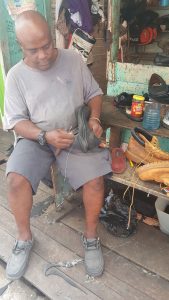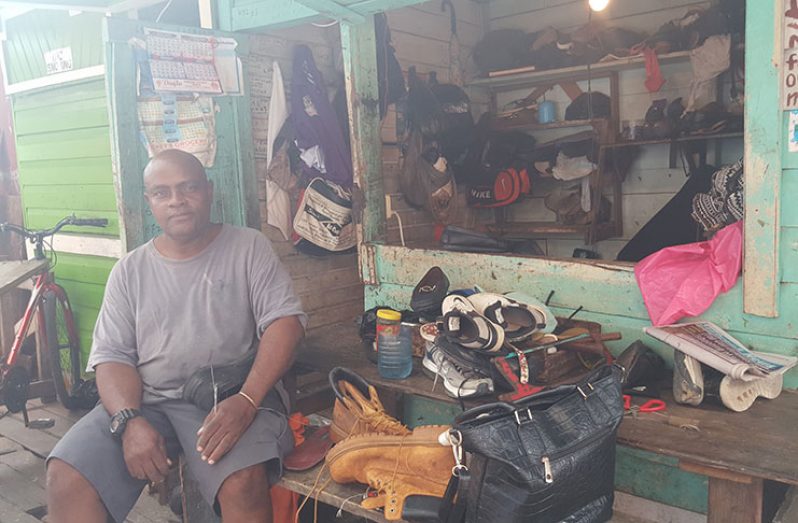Joseph Osborne reflects on his last 30 years as a cobbler
BACK in the day, a cobbler was regarded as being of high status with the profession itself dating back hundreds of years, but in today’s world, including in Guyana, the profession is slowly fading away.
Today there is a sprinkle of cobblers around the local markets since most folks prefer to buy a new pair of shoes rather than repair the damaged ones.
The Pepperpot Magazine spoke with 60-year-old Joseph Osborne who plies his trade at Bourda Market among 13 other cobblers who operate in their little shops.
For this East Coast Demerara resident, the profession is one that chose him, not one that he chose. It all started when he showed up at the spot to assist a friend with repairing shoes. He ended up staying there for work and has been there ever since.
Many years ago, Osborne said he did a crash-course in leather craft and that has helped him along the way as a cobbler but back then, he had the desire to become a driver with one of the ministries but that dream was short-lived when he got accustomed to working at his own pace.
The father of five related that he never intended to become a cobbler, in fact, he had a great-uncle who was a cobbler and he used to laugh at him, not knowing he would have that job later on.
He stated that back then, they had their way of repairing shoes where they would put wax on the hem, and while sewing is still done by hand today, there are tools to assist in this regard.
Osborne told the Pepperpot Magazine that being a cobbler isn’t an easy job because often it is a difficult task to please some customers – both men and women. He pointed out too, some customers would bring several pairs of shoes to be repaired and would never show up to retrieve it.

This cobbler said after at least one year, he would discard those unclaimed shoes. He explained that at times he would only start repairing a pair of shoes when the customer returned for them.
He regards the experience as good in many aspects because his aims is to please the customer by doing a good job.
“It is not what you do, it is how you do it,” Osbourne said, referencing the old adage- a motto he used as a guide to being a cobbler. The job has provided for his family over the years even though it did not bring in a lump sum of cash but at the end of the day, he had money in his pockets.
HONEST LIVING
This grandfather of seven told the Pepperpot Magazine that on a regular day a cobbler may or may not earn a lot but it is an honest job. It entails great patience and sometimes there is little to do even when the stall is full of shoes to be fixed.
Osborne admits that most people do not repair shoes unless it is their favourite pair and mostly women would show up with sandals, slippers and high heel shoes to be re-soled, affixed with new heels or stitched.
He added that men would require their boots and shoes be repaired at the earliest and the term “the customer is always right” is a misinterpreted concept because some people know they are wrong and want to be right.
Osborne said a pair of shoes cost GY$300, $400 or $600 to be stitched and some folks don’t even want to pay that amount for his service. He also regards the job as a learning process in which one can never fully master.
Osborne noted that a cobbler operates from as early as 09:00hrs to 17:00hrs on any given day and sometimes he would stay late if it is required of him.
He added that he prefers to work with himself even though it is a slow business because he cannot work with a boss or wants to be told what to do and as is, he works at his own pace and in relative ease.





.jpg)








